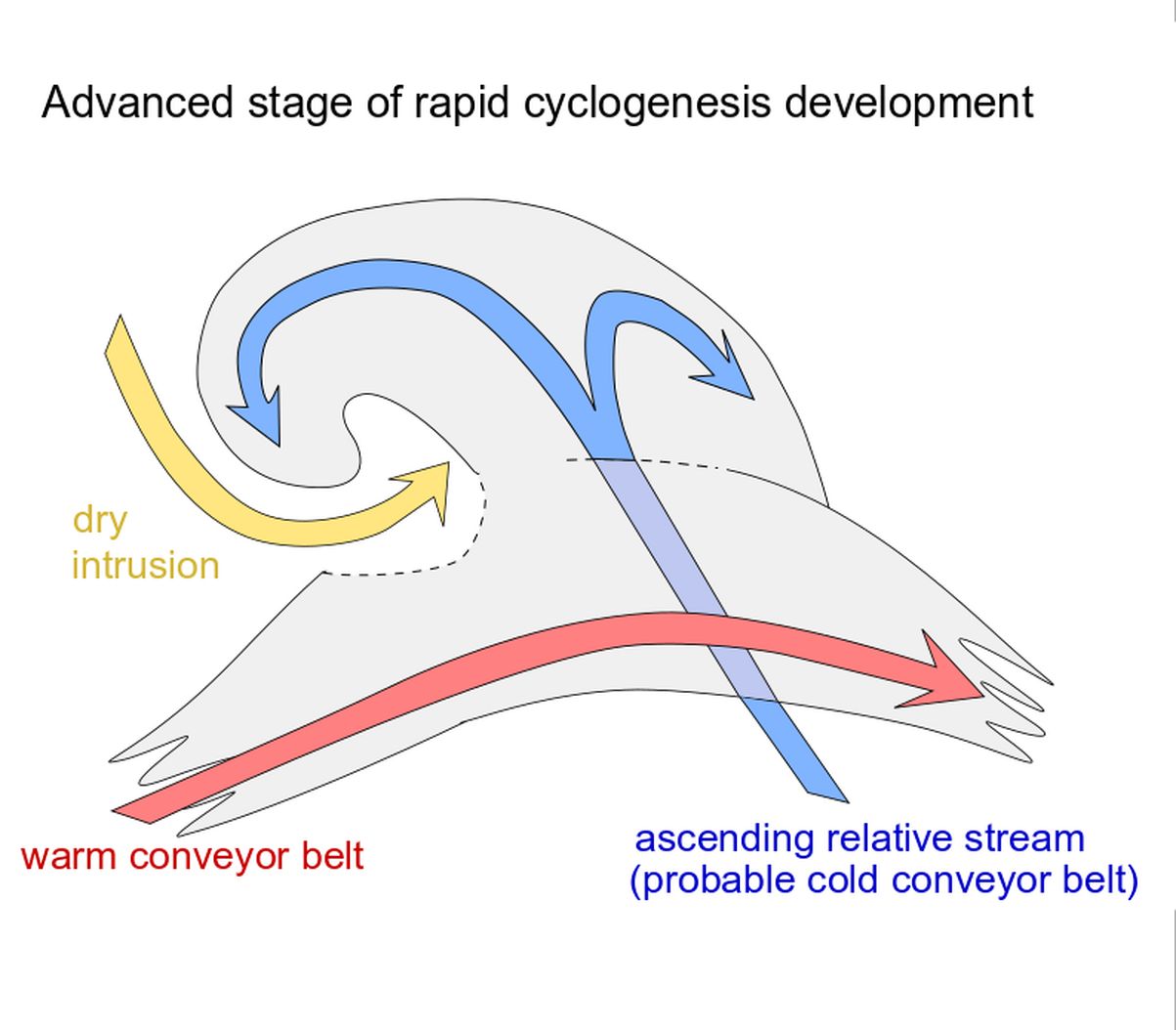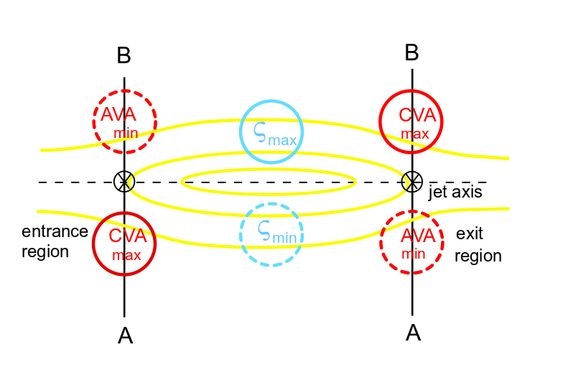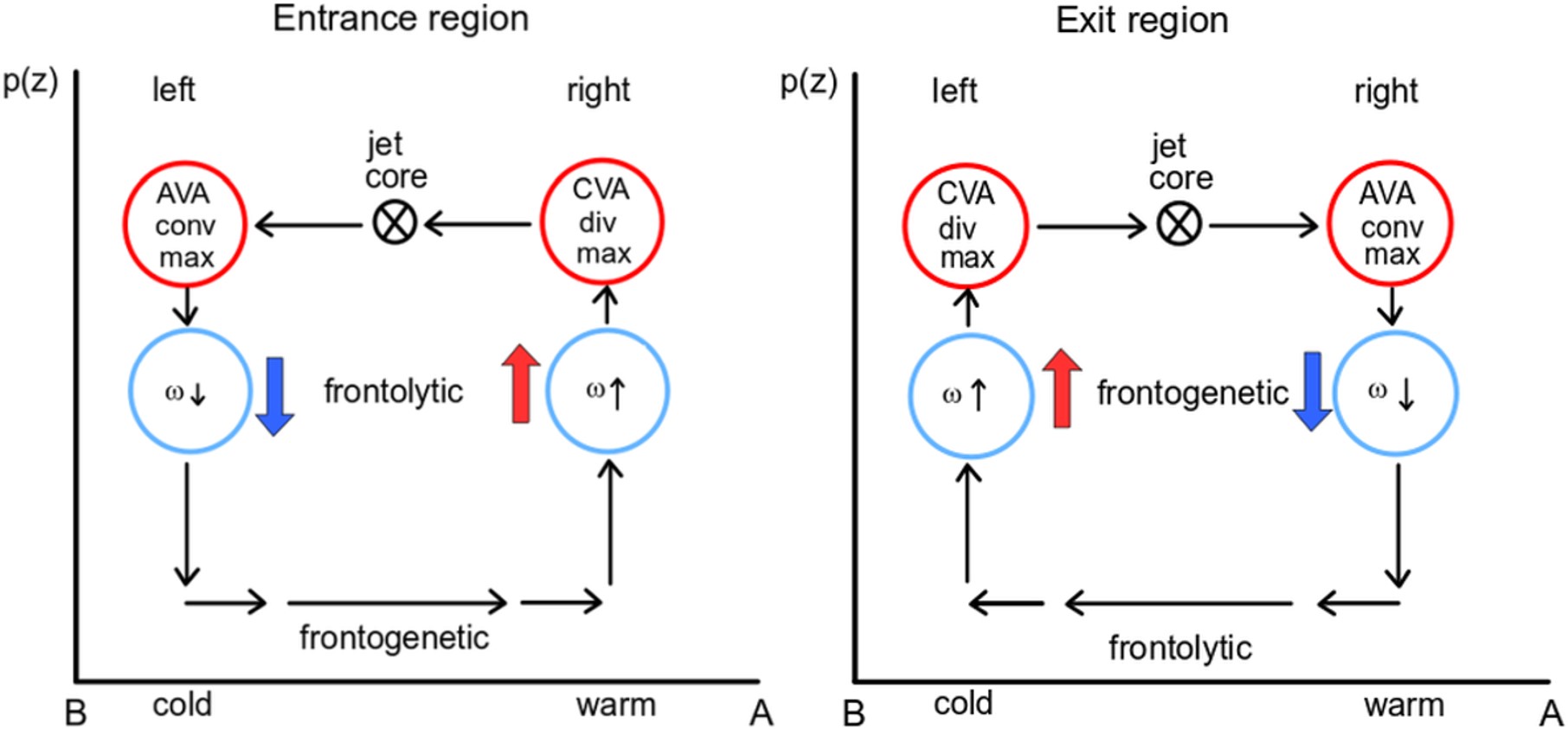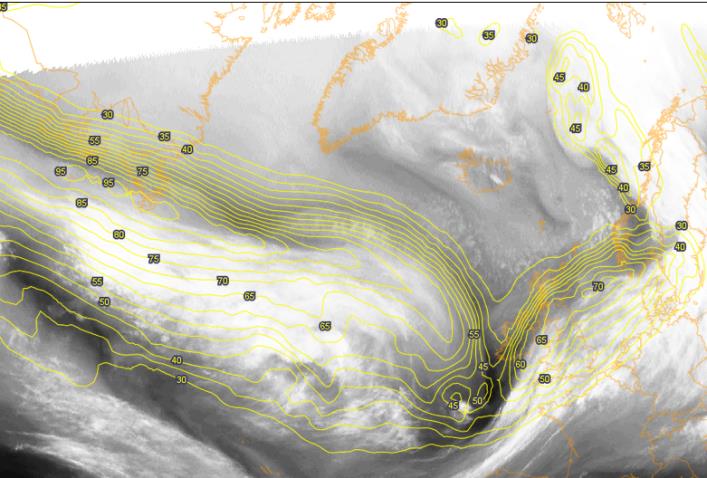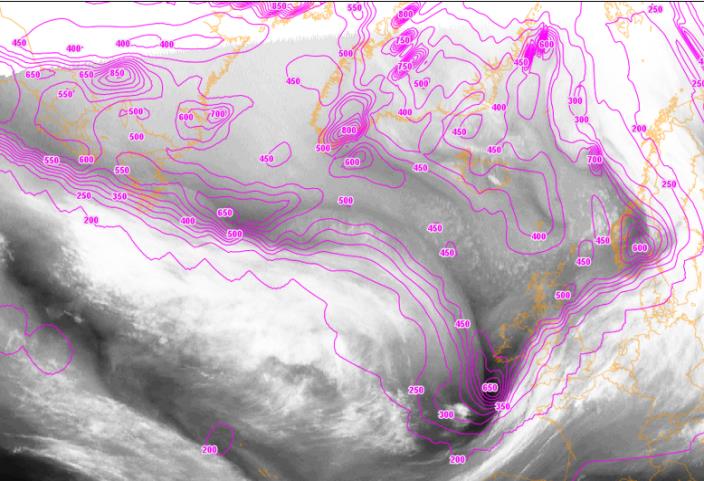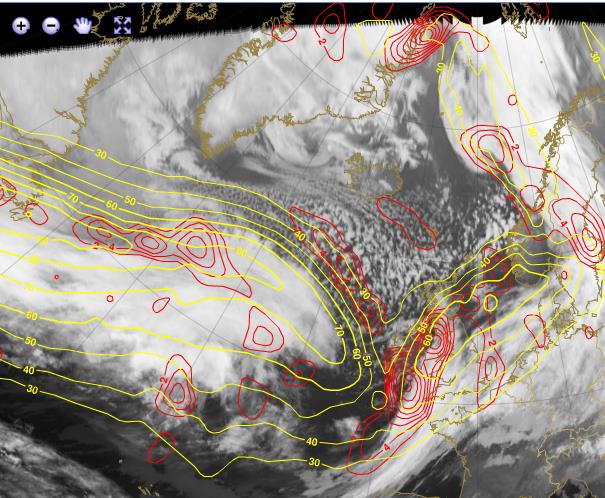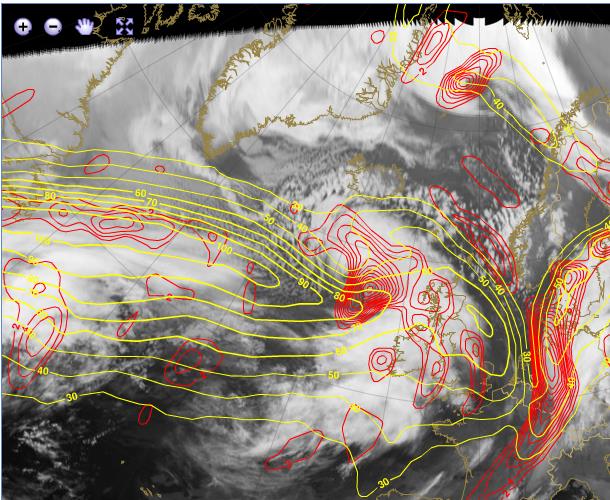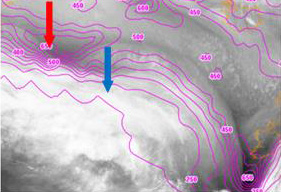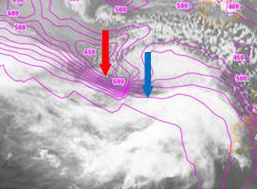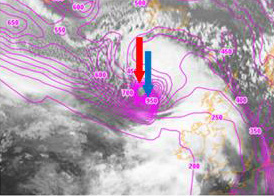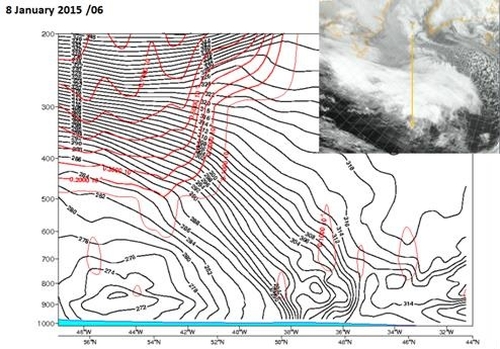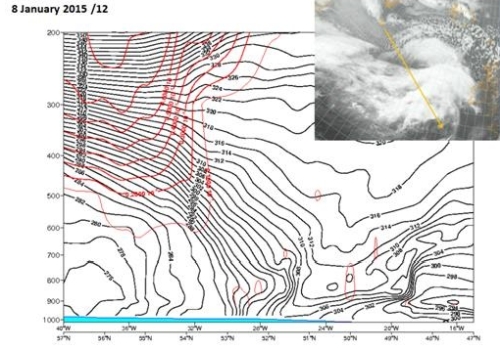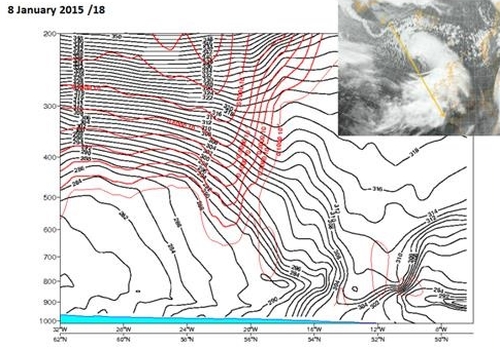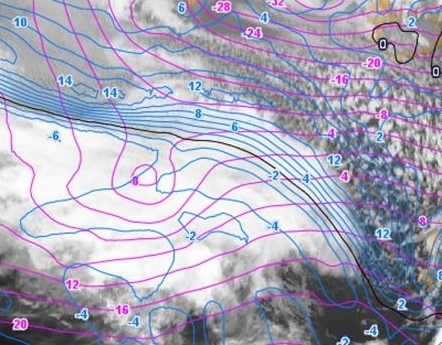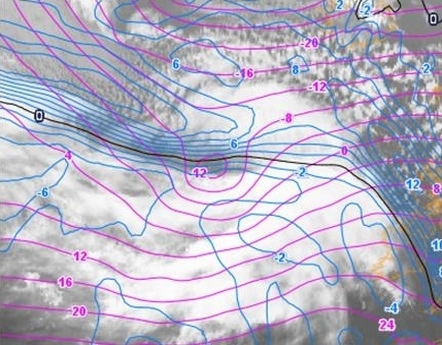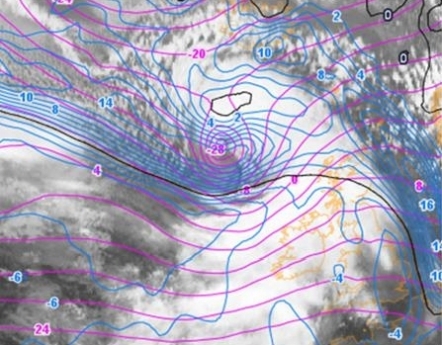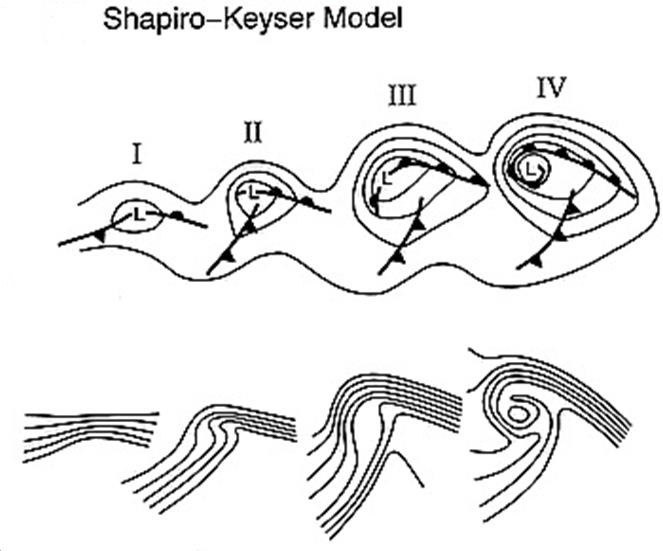Meteorological And Physical Background
A Rapid Cyclogenesis is accompanied by distinct and typical cloud configurations in satellite images. Other names have been used in the literature to describe the same conceptual model, such as "explosive cyclogenesis" or "bomb" as well as names which describe only parts of the whole conceptual model, such as "emerging cloud head", "cyclogenesis within the left exit region of a jet streak" or "comma cloud".
1. Polar front theory and Rapid Cyclogenesis
The biggest differences between the the developments of classical polar fronts and Rapid Cyclogenesis are in the first phase. Here that is taken to be the stage between the first sign of a V-pattern (dry slot) and the development of a cloud spiral.
While a classical cyclogenesis through wave development is often slow and the wave bulge dissolves after some time or produces a spiral only after some days, the development of a Rapid Cyclogenesis is faster. The dry slot (V-pattern) typically evolves into a cloud spiral within 12 hours. After the mature stage is reached there is no longer any notable difference between the two processes.
The fast development of Rapid Cyclogenesis in its initial stage cannot be explained within the framework of the classical polar front theory developed by Bjerknes and Solberg (see Meteorological Physical Background of "Occlusion warm conveyor belt" and "Occlusion cold conveyor belt"). Consequently we must consider other processes and conditions that lead to rapid and intensive development.
From the features of WV and Airmass RGB images it is evident that sinking dry air has a significant impact on the cloud configuration.
2. Conveyor Belt Model
Features like a protruding cloud head suggest the theory of relative streams (see Basics, relative streams) as a likely method of investigation for a deeper understanding of cloud configurations.
As shown in the conceptual models "Occlusion: Cold Conveyor Belt Type" and "Occlusion: Warm Conveyor Belt Type" there are several conveyor belts involved in the development of a cyclogenesis, resulting in different cloud systems. This can be seen in the schematics below. The cloudiness of the main frontal zone is produced by a typical warm conveyor belt together with a humid relative stream from behind, the "upper relative stream" while the dry stream from behind, the dry intrusion, appears behind the poleward edge of the frontal cloud band. This stream often contains stratospheric air.
As the schematics of the initial stages show, the warm conveyor belt and dry intrusion are also involved in the rapid cyclogenesis types. But there are also differences to the classical occlusion types: the cloud head of a Rapid Cyclogenesis is formed within the lower and mid-levels of the troposphere by a rapidly ascending relative stream (conveyor belt) from the south, which advects moist air from lower latitudes beneath the warm conveyor belt of the frontal zone. This relative stream of a Rapid Cyclogenesis has several similarities with the cold conveyor belt in the polar front theory of cyclogenesis, which also is an ascending relative stream below the warm conveyor belt, forming the cloudiness of the occlusion spiral. But such a cold conveyor belt usually originates from the east and is usually less warm and humid. So, it is not evident if the cold conveyor belt in connection with an occlusion spiral and the ascending relative stream in connection with the cloud head are same or comparable.
After crossing the cold front zone the ascending conveyor belt often splits into two branches that flow east and west. This splitting of the relative flow leads to the convex-shaped cloud edge at the poleward side of the cloud head. Also a cold conveyor belt sometimes shows this splitting effect.
As the advected air of the dry intrusion originates from the upper troposphere and the lower stratosphere, this flow is characterized by high values of potential vorticity. A potentially unstable stratification of the troposphere develops in the area where the dry intrusion flow over the ascending conveyor belt from the south. This is one of the factors that contribute to the development of convective storms in the same area (see the chapters 'Weather events' and 'Cloud structure in satellite images'). This is indicated in the schematic of the Advanced Stage below.
Fig. 11a: Development stages
Fig. 11b: Advanced stage
3. Jet, Jet streaks and 4-Quadrant Model by Uccellini
As mentioned above, the speed of a rapid cyclogenesis's development cannot be explained with the polar front theory alone; a different process is needed for a more detailed explanation. Rapid developments take place in the left exit region of jets and jet streaks. The structure of dark stripes along the rear edge of the frontal cloud band, which is best seen in WV images and Airmass RGB, also indicate that jets play an important role in the process of a Rapid Cyclogenesis.
Therefore, in addition to the development models of polar fronts and conveyor belts, upper air phenomena like the 4-quadrant jet streak model from Uccellini are taken into consideration and - as will be shown - play key roles.
Jet streaks can have straight or curved axes; during the initial stages of a Rapid Cyclogenesis the axes are mostly straight.
Fig. 12: Jet streak model
Jet streaks are the areas of maximum wind speed within the jet streams. The most interesting regions from the viewpoint of cyclonic developments are the entrance region where air particles accelerate, and the exit region where the air particles decelerate. As a consequence of these accelerations ageostrophic wind components develop in these regions, which leads to vertical movements.
Fig. 13: Vertical cross section of a jet
Both entrance and exit regions are favorable for frontogenesis, although in different ways.
In the entrance region the frontogenetic process occurs mostly in the lower troposphere, which causes the process to last a longer time, typically more than 24 hours.
In the exit region the frontogenetic area lies in the middle troposphere, where the PVA maximum connects to the left exit region. These circumstances favour a rapid (under 12 hours) cyclogenesis.
The jet stream axis lies parallel to the frontal cloud band with dry stratospheric air approaching the cloud head. This is the black stripe typically seen in WV imagery. Also, the PV values there are higher than 1 PVU. The emerging cloud head in the initial and development stage of the Rapid Cyclogenesis usually appears in the left exit region of a jet streak. This can be seen in the following WV 6.3 μm image from 8 January 2015 at 06 UTC with isotachs at 300 hPa, height of PVU > 2 and the PVA maximum at 300 hPa superimposed.
While there is ascending motion below the left exit region of the jet streak, descent takes place below the right exit region.
Quite often, and especially in cases with Rapid Cyclogenesis, this sinking motion leads to the dissolution of the cold front cloudiness. This can be seen clearly in the following image from 8 January 2015. The green star indicates the right exit region of the jet streak, where the cold front cloudiness has dissolved.
Fig. 15: 8 January 2015, 18 UTC - Meteosat 10; IR 10.8 image; yellow: isotachs 300 hPa; red: positive vorticity advection 300 hPa.
In summary, the part of the cloud head where the rapid development happens is an area of upward motion and cyclogenesis in the left exit region of a jet streak, and at same time an area where stratospheric air has protruded far downward, a so-called PV anomaly. This last fact in particular shows a difference between a classical polar frontal cyclogenesis and a Rapid Cyclogenesis; while in the case of classical wave development stratospheric air (if present at all) reaches the layer between 300 and 500 hPa, in the case of Rapid Cyclogenesis stratospheric air is a key feature and protrudes much further downward, with 500 hPa reached in the beginning of the process. This development process in the left exit region goes hand in hand with the dissolution of cold front cloudiness in the right entrance region.
4. Potential Vorticity
As demonstrated before, the development conditions in the left exit region of a jet streak can explain the rapid developments. On the other hand, there are also cases - especially in the cold conveyor belt (CCB) occlusion conceptual model - where the occlusion cloud band lies in the left exit region and thus under its physical influence. Therefore, there must still be yet another process to explain why some polar front developments are rapid and some are not.
The development of Rapid Cyclogenesis can be explained by the theory described by Hoskins et al. involving potential vorticity anomalies and their interaction with low-level baroclinic zones. (Compare: Basics/Numerical Parameters for Synoptic- to Mesoscale Cloud Systems /Potential Vorticity)
Fig. 16: Potential vorticity equation
When stratospheric air protrudes downward into the troposphere an upper level PV anomaly develops. As a consequence of the PV equation, positive vorticity will become more cyclonic because of the influence of the less stable environment of the troposphere.
When a positive upper level PV anomaly is being advected over a zone of strong, low-level temperature gradient a rotation is induced in the lower levels of the baroclinic zone, which causes warm advection at these levels and intensifies the cyclonic vortex there.
What takes place is a mutual intensification of cyclonic rotation from high to low and from low to high levels. The downward protrusion of high PV values can be seen in vertical cross sections. This does not mean that stratospheric air reaches the surface layers, but that the protrusion intensifies rotation in the lower layers.
In the schematic below the thick solid arrow around the PV maximum indicates the cyclonic rotation. This rotation is induced at lower levels of the baroclinic zone as shown by the thin solid circulation arrow. This low level circulation causes warm advection ahead leading to a low level positive temperature anomaly indicated by the open + sign in the right figure (b). This temperature anomaly is associated with a cyclonic vortex which is marked by the open arrow at low levels. In turn, this circulation has a positive feedback to the upper troposphere, shown by an open circulation arrow at higher levels.
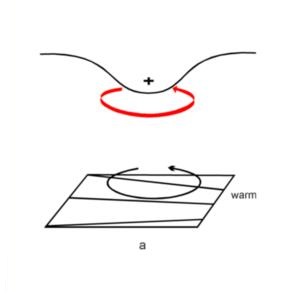 |
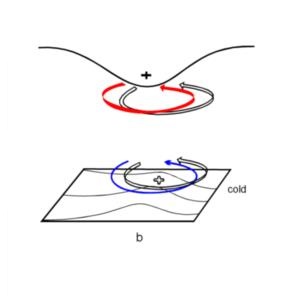 |
| Fig. 17a: Positive PV anomaly. | Fig. 17b: Positive PV anomaly causing positive temperature advection. |
At the same time another process is taking place: The induced low level vortex results in a strong equatorward wind component under the upper level PV anomaly. This southward component also influences the higher levels and leads to an equatorward advection of the upper level PV-anomaly which in turn intensifies the upper level wave.
Within this increased flow higher PV values to the west of the PV-anomaly are advected southward and lower PV values to the east of the PV-anomaly are advected northward. As a consequence of the latter process, the eastward movement of the PV-anomaly is decreased. Hence, the interaction between low and upper level circulations and the already ongoing cyclogenesis process will strengthen.
The next three images show the development of a Rapid Cyclogenesis. A PV anomaly (red arrow) protrudes downward and approaches the location of the surface low center (blue arrow) and simultaneously the cloud head turns into a cloud spiral.
At 06 UTC an intensive PV anomaly is located behind the cloud head, parallel to the frontal cloud band. The (dynamical) tropopause, here indicated with the height of 1 PVU, has lowered to a minimum level of 650 hPa. Six hours later a V pattern has developed. At 18 UTC the PV anomaly has reached the location of the surface low and lowered to 950 hPa.
In the following vertical cross sections the downward protrusion of the PV anomaly is seen even more clearly: the minimum of 950 hPa was already reached by 12 UTC.
Another sign of the interaction between high and low layers is the movement and intensification of the surface low. In the beginning it is rather weak and situated on the anticyclonic side of the jet streak. During the development it moves to the cyclonic side and intensifies strongly when it encounters the left exit region. In the case of 8 January 2015 the height of 1000 hPa surface drops by 8 to 28 dam within 12 hours.
5. Under discussion: Another Rapid Cyclogenesis development model
Another theory of cyclogenesis that also deviates from classical polar front theory has been discussed in the literature more and more often in the last decades. It is the Shapiro-Keyser cyclone model and it is mentioned here because some authors suggest that a Rapid Cyclogenesis is the result of this cyclogenetic process.
Although most of the presented case studies do not contain and take into account satellite images and the typical cloud configurations, the theory will be briefly summarized here.
According to the Shapiro-Keyser model, cyclogenesis deviates from Bjerknes and Solberg's polar front theory from a phase immediately after the wave development to the end stage of the spiral structure. The cold front is weak and soon dissipates from the warm front. In contrast, the warm front is very strong and starts to rotate around the low center, creating a warm seclusion. This development often occurs in west-east oriented fronts with air masses from warmer latitudes, and in the area of confluent flows in jet streak entrance regions.
Fig. 21: Shapiro-Keyser cyclogenesis model
The polar front theory of Bjerknes and Solberg is an occlusion process in which a cold front catches up to a warm front and lifts warm air upward. The Shapiro-Keyser model is based on the idea of wrapping the different air masses around the center, resulting in the warm seclusion.
There are some similarities between Rapid Cyclogenesis events and the Shapiro-Keyser model, such as the west-east orientation of the frontal system, the very intensive warm advection in the warm front and cloud head cloudiness (especially in the beginning of the process), the dissolution of cold front cloudiness in a more advanced stage, and, in nearly all cases, a recognizable cloud spiral around the low center in the final stage.
However, Rapid Cyclogenesis also deviates from the Shapiro-Keyser model in important ways. In the case of Rapid Cyclogenesis, the main development takes place in the left exit region of a jet streak, which is to say: in the diffluence and not the confluence area of a jet streak. Also, if one looks into the development of cloud configurations in satellite images, frontal (especially warm front) cloudiness and cloud heads are clearly different configurations which are best explained with conveyor belts.
Further investigation is recommended to clarify the open questions.

